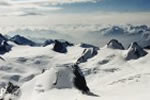


 |
 |
 |
What Determines The Impact Of An Earthquake?
Economic Development Of The Location
More economically developed countries (MEDC's) tend to survive earthquakes better than less economically developed countries (LEDC's). There are three main reasons for this.
1. MEDC's are likely to have buildings designed to withstand earthquakes. They have the money and systems to make sure that buildings are carefully designed to withstand shaking, and can afford to add safety features to older buildings that may be at risk. They may have huge rubber pads built into the foundations (seismic isolators) or very deep foundations to hold them firmly in place. In 1995 the Kobe earthquake hit in Japan. Measuring 7.2 on the Richter scale it had the potential to cause massive damage to vulnerable buildings, but because many buildings were designed to withstand earthquakes, only 5000 people were killed.
LEDC's often can't afford to build new structures to the same standards as MEDC's, they have a greater chance of poor quality construction, and they lack the money to upgrade older buildings. In contrast to the Kobe earthquake that killed 5000, an earthquake of a slightly smaller intensity hit Turkey in 1999. It killed 17,000 people.
2. MEDC's have disaster plans, government departments responsible for managing and coordinating emergency responses, and for educating the public about natural hazards. In Japan, all school children practice earthquake drill in the same way that we practice fire drill in the UK. Emergency services actually practice through simulations, so they know exactly what they should do if disaster strikes. Most LEDC's don't have enough money to develop emergency plans, buy the response equipment and training needed, and conduct very expensive training exercises involving thousands of people.
3. MEDC's are self reliant. They can afford to allocate funds to 'just in case' measures. They keep emergency stocks of medicines, tents, blankets, food, water, and communications equipment. It's kept ready for use and constantly updated. Many LEDC's struggle to provide these facilities for normal use let alone keep a spare set of everything in case of disasters.
The speed with which these resources reach an area is critical to reducing deaths. MEDC's have the resources close at hand and can be sending them out within hours. By contrast, LEDC's often have to ask for help, and mobilising international aid can take days. A homeless person in San Francisco who gets shelter, food and medical aid within 12 hours has a much better chance of survival than a Turkish farmer who will be waiting for days or even weeks before aid reaches him.
Urban or Rural Area
This is all about how many people are around, or population density. If a 'quake hits a rural area with few buildings and few people, the damage will be small. If the same quake hits an area with many more buildings and people, the damage will be greater. The Loma Prieta earthquake ,in San Francisco, killed people and caused millions of dollars of damage. If the same quake had hit the middle of Alaska a few moose, bears and trees would have suffered but human casualties would have been almost zero.
Distance From The Epicentre
The epicentre is the point on the Earth's surface directly above the source, or focus, of the earthquake. It is the point on the surface nearest to the earthquake. The power of the shock waves decreases with distance from their source, so this means that the shock waves from the earthquake are strongest at the epicentre and have the potential to do most damage there. The potential to cause damage decreases as distance from the earthquake epicentre increases. This is why there can be massive damage at the epicentre but no indication of the earthquake at all a few hundred miles away.
Weather and Season
Generally, when earthquakes leave people homeless or trapped, more people will die in cold or wet weather. Winter is the worst time to be left exposed to the weather, and those who survive the earthquake will be at risk of hypothermia, frostbite and illnesses caused by long exposure to dampness and cold. Bad weather also hampers rescue efforts and makes recovery from the disaster much harder. In cold weather it is also more likely that houses will have contained stoves and fires that were burning when they collapsed, greatly increasing the chances of fires after the shock waves have gone.
'Quakes that strike in warm dry weather also have specific problems, but these are more associated with hygiene. High temperatures make it harder for trapped people to survive in the rubble because although you can live a long time without food, you die quickly without water. Heat also speeds up the decomposition of the bodies of those who die which, like broken sewer pipes, uncollected rubbish and dead animals, quickly become sources of bacteria and vermin that spread diseases. It only takes one dead animal/person in a water supply to make that water totally undrinkable.
When considering whether Winter or Summer is worse, you should look at the typical climate for those seasons in the area affected. For example, an earthquake in India during the very wet Monsoon Season could be far more damaging to the health of survivors than an identical earthquake during the dry period just before the Monsoon.
Time Of Day and Day Of The Week
The day of the week is an issue mainly in built up areas such as cities. During the working week many people are gathered in towns and cities, and huge numbers will be working in vulnerable buildings such as high rise office blocks. During the weekend, however, those people stay at home and are dispersed over a much wider area. The collapse of a house may kill or injure a single family, whereas an office block collapsing could kill hundreds of people.
The time of day is important too. For example, most people are at home in bed at 3am, so they are spread out across a wide area, and lying down and even protected from falling plaster etc by their bedding. Those same people at 8am would be driving cars, sitting on trains or busses, or walking around. They would be far more vulnerable to the earthquake effects. The same would apply in the evening as people went home again. The Loma Prieta earthquake in San Francisco (1989) struck at about 5pm and a number of people died in their cars when freeway bridges collapsed onto them.
The Kobe earthquake (Japan) in 1995 struck early in the morning, at 5.46am. Many people were either starting up their cooking stoves or already cooking breakfast. When the shock waves ruptured gas pipes the escaping gas was quickly ignited by cookers, broken electrical wires and stoves that had been thrown over. Over 300 fires were started and almost 7000 buildings were destroyed by fire alone.
Emergency Services and Earthquake Response Plans
Developed countries usually have better trained and better funded emergency services. They also tend to have planning regulations to make sure that buildings in earthquake risk areas are built to withstand shaking. In LEDC's resources are less likely to be available. After the Indian earthquake in Gujarat (2001) the Indian government blamed the Gujarat authorities for not having disaster plans, for not educating people about what to do if an earthquake occurred, and for not having systems in place to make sure that buildings were built to withstand earthquakes. Some sections of the Gujarat authorities responded, saying that they didn't have the money to do it, and pointed out that it was normal for the Indian Army to come to the rescue when natural disasters struck, so why did they need plans of their own?
By contrast, California in the USA spends millions of dollars on earthquake planning, training the emergency services, developing systems to get relief supplies to effected areas and getting casualties out to safety. However, despite extensive planning things can still go wrong.
As a general rule though, countries with wealth can afford safer buildings and better emergency response systems, and also put recovery schemes in place more quickly than poorer countries.
Landscape and rock type
Have you ever stood on the beach and wriggled your toes in the wet sand? If you have, you probably noticed that if you get the wriggling right the sand behaves like a liquid and your feet can sink easily into it. This is called liquefaction, and it happens when soil containing plenty of water is shaken or vibrated. A soil that is usually firm enough to support buildings can turn to wobbly jelly during an earthquake and no longer be able to support buildings. This happened in Kobe in 1995 when reclaimed land around the docks was turned into thick soup, allowing buildings to topple sideways, resulting in the huge cranes in the harbour toppling over into the sea.
Harder and more solid rocks, such as granite, won't liquefy or turn to thick soup so they are often safer areas in which to site buildings. Having said this, nothing is totally safe in an earthquake if it is powerful enough. Around the coast of New Zealand are raised beaches caused by past earthquakes uplifting entire stretches of the coastline in just seconds! Imagine, one moment its the seabed under a few metres of water, and a few seconds later it's dry land a few metres above sea level. When you are facing forces like that, nothing can be guaranteed as safe!
The shape of the landscape, or it's topography to use the geographical term, also influences the effects of some earthquakes. Earthquakes that have their epicentres on the seabed can trigger a tsunami, or wave of water that travels out from the epicentre. Where this meets a low lying coast, the wave can travel considerable distances inland, sweeping away everything in it's path.
Mountainous areas tend to have steep hillsides and narrow roads cut into the sides of hills. Steep slopes are less stable than flat land and more easily disturbed by shock waves. It's common for landslides to occur and for roads to either be destroyed or covered by falling rock and soil debris from the slopes above them. This has serious consequences, cutting off remote mountain areas and preventing aid from reaching them.
If you had to pick a place to be when a really severe earthquake struck, probably the best place to be would be...
1. Well inland, away from the sea and large areas of water so you don't get caught by a tsunami, broken dam, river changing direction etc.
2. On solid rock such as granite, limestone or basalt which won't liquefy or distort.
3.On flat ground with no overhanging cliffs, hills or trees, so nothing will fall on you.
4. Outside and well away from any buildings again, so nothing will fall on you.
5. Lying or sitting down, so you don't fall over and hurt yourself.
![]()
